Appearance Dark red crystals IUPAC ID Chromic acid Density 1.2 g/cm³ Melting point 197 °C | Formula H2CrO4 Molar mass 118.01 g/mol Boiling point 250 °C Soluble in Water | |
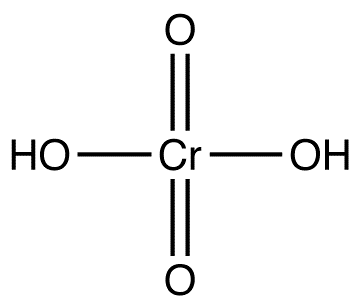 | ||
The term chromic acid is usually used for a mixture made by adding concentrated sulfuric acid to a dichromate, which may contain a variety of compounds, including solid chromium trioxide. This kind of chromic acid may be used as a cleaning mixture for glass. Chromic acid may also refer to the molecular species, H2CrO4 of which the trioxide is the anhydride. Chromic acid features chromium in an oxidation state of +6 (or VI). It is a strong and corrosive oxidising agent.
Contents
- Tollens reagent mechanism lucas chromic acid test organic chemistry
- Molecular chromic acid
- Dichromic acid
- Uses
- Reactions
- Illustrative transformations
- Use in qualitative organic analysis
- Alternative reagents
- Safety
- References
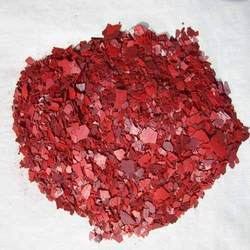
Tollens reagent mechanism lucas chromic acid test organic chemistry
Molecular chromic acid
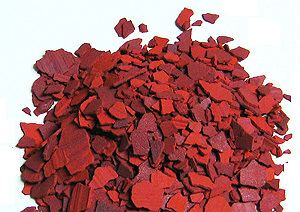
Molecular chromic acid, H2CrO4, has much in common with sulfuric acid, H2SO4. Both are classified as strong acids, though only the first proton is lost easily.
H2CrO4 ⇌ [HCrO4]− + H+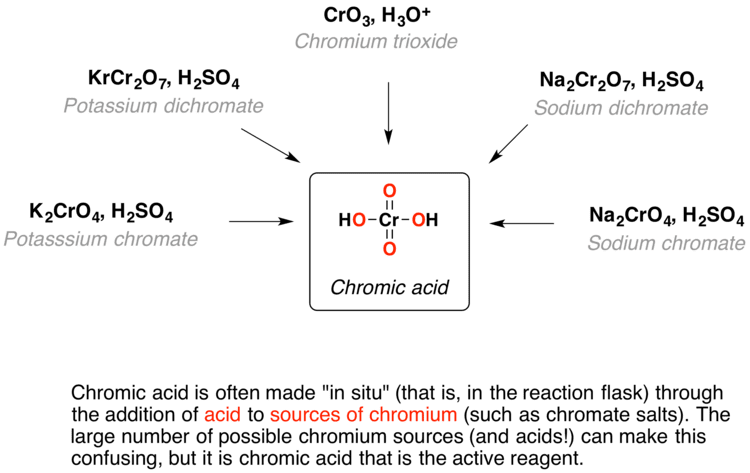
The pKa for the equilibrium is not well characterized. Reported values vary between about −0.8 to 1.6. The value at zero ionic strength is difficult to determine because half dissociation only occurs in very acidic solution, at about pH 0, that is, with an acid concentration of about 1 mol dm−3. A further complication is that the ion [HCrO4]− has a marked tendency to dimerize, with the loss of a water molecule, to form the dichromate ion, [Cr2O7]2−:
2 [HCrO4]− ⇌ [Cr2O7]2− + H2O log KD = 2.05.Furthermore, the dichromate can be protonated:
[HCr2O7]− ⇌ [Cr2O7]2− + H+ pK = 1.8The pK value for this reaction shows that it can be ignored at pH > 4.
Loss of the second proton occurs in the pH range 4–8, making the ion [HCrO4]− a weak acid.
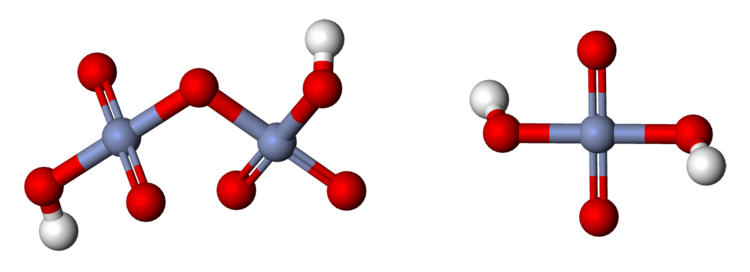
Molecular chromic acid could in principle be made by adding chromium trioxide to water (cf. manufacture of sulfuric acid).
CrO3 + H2O ⇌ H2CrO4but in practice the reverse reaction occurs when molecular chromic acid is dehydrated. This is what happens when concentrated sulfuric acid is added to a dichromate solution. At first the colour changes from orange (dichromate) to red (chromic acid) and then deep red crystals of chromium trioxide precipitate from the mixture, without further colour change. The colours are due to LMCT transitions.
Chromium trioxide is the anhydride of molecular chromic acid. It is a Lewis acid and can react with a Lewis base, such as pyridine in a non-aqueous medium such as dichloromethane (Collins reagent).
Dichromic acid
Dichromic acid, H2Cr2O7, (structure illustrated top right) is the fully protonated form of the dichromate ion and also can be seen as the product of adding chromium trioxide to molecular chromic acid.
[Cr2O7]2− + 2H+ ⇌ H2Cr2O7 ⇌ H2CrO4 + CrO3It is probably present in chromic acid cleaning mixtures along with the mixed chromosulfuric acid H2CrSO7.
Uses
Chromic acid is an intermediate in chromium plating, and is also used in ceramic glazes, and colored glass. Because a solution of chromic acid in sulfuric acid (also known as a sulfochromic mixture or chromosulfuric acid) is a powerful oxidizing agent, it can be used to clean laboratory glassware, particularly of otherwise insoluble organic residues. This application has declined due to environmental concerns. Furthermore, the acid leaves trace amounts of paramagnetic chromic ions — Cr(III) — that can interfere with certain applications, such as NMR spectroscopy. This is especially the case for NMR tubes.
Chromic acid was widely used in the instrument repair industry, due to its ability to "brighten" raw brass. A chromic acid dip leaves behind a bright yellow patina on the brass. Due to growing health and environmental concerns, many have discontinued use of this chemical in their repair shops.
It was used in hair dye in the 1940s, under the name Melereon.
As a bleach in black and white photographic reversal processing.
Reactions
Chromic acid is capable of oxidizing many kinds of organic compounds and many variations on this reagent have been developed:
Illustrative transformations
Use in qualitative organic analysis
In organic chemistry, dilute solutions of chromic acid can be used to oxidize primary or secondary alcohols to the corresponding aldehydes and ketones. Tertiary alcohol groups are unaffected. Because of the oxidation is signaled by a color change from orange to a blue-green, chromic acid is used as a qualitative analytical test for the presence of primary or secondary alcohols.
Alternative reagents
In oxidations of alcohols or aldehydes into carboxylic acids, chromic acid is one of several reagents, including several that are catalytic. For example, nickel(II) salts catalyze oxidations by bleach (hypochlorite). Aldehydes are relatively easily oxidised to carboxylic acids, and mild oxidising agents are sufficient. Silver(I) compounds have been used for this purpose. Each oxidant offers advantages and disadvantages. Instead of using chemical oxidants, electrochemical oxidation is often possible.
Safety
Hexavalent chromium compounds (including chromium trioxide, chromic acids, chromates, chlorochromates) are toxic and carcinogenic. For this reason, chromic acid oxidation is not used on an industrial scale except in the aerospace industry.
Chromium trioxide and chromic acids are strong oxidisers and may react violently if mixed with easily oxidisable organic substances. Fires or explosions may result.
Chromic acid burns are treated with a dilute Sodium thiosulfate solution.
